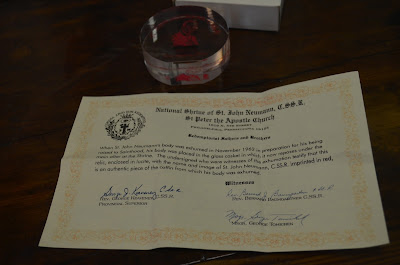Simple (1955 Calendar): July 27
St. Pantaleon is numbered in the West among the late-medieval
Fourteen Holy Helpers and in the East as one of the Holy Unmercenary Healers. He was a martyr of Nicomedia in Bithynia during the Diocletian persecution of 303 AD.
Taken from the Catholic Encyclopedia:
Martyr, died about 305. According to legend he was the son of a rich pagan, Eustorgius of Nicomedia, and had been instructed in Christianity by his Christian mother, Eubula. Afterwards he became estranged from Christianity. He studied medicine and became physician to the Emperor Maximinianus. He was won back to Christianity by the priest Hermolaus. Upon the death of his father he came into possession of a large fortune. Envious colleagues denounced him to the emperor during the Diocletian persecution. The emperor wished to save him and sought to persuade him to apostasy. Pantaleon, however, openly confessed his faith, and as proof that Christ is the true God, he healed a paralytic. Notwithstanding this, he was condemned to death by the emperor, who regarded the miracle as an exhibition of magic.
According to legend, Pantaleon's flesh was first burned with torches; upon this Christ appeared to all in the form of Hermolaus to strengthen and heal Pantaleon. The torches were extinguished. After this, when a bath of liquid lead was prepared, Christ in the same form stepped into the cauldron with him, the fire went out and the lead became cold. He was now thrown into the sea, but the stone with which he was loaded floated. He was thrown to the wild beasts but these fawned upon him and could not be forced away until he had blessed them. He was bound on the wheel, but the ropes snapped, and the wheel broke. An attempt was made to behead him, but the sword bent, and the executioners were converted. Pantaleon implored heaven to forgive them, for which reason he also received the name of Panteleemon (the all-compassionate). It was not until he himself desired it that it was possible to behead him.
The lives containing these legendary features are all late in date and valueless. Yet the fact of the martyrdom itself seems to be proved by a veneration for which there is early testimony, among others from Theodoret (Graecarum affectionum curatio, Sermo VIII, "De martyribus", in Migne, P.G., LXXXIII 1033), Procopius of Caesarea (De aedificiis Justiniani I, ix; V, ix), and the "Martyrologium Hieronymianum" (Acta SS., Nov., II, 1, 97). Pantaleon is venerated in the East as a great martyr and wonderworker. In the Middle Ages he came to be regarded as the patron saint of physicians and midwives, and became one of the fourteen guardian martyrs. From early times a phial containing some of his blood has been preserved at Constantinople. On the feast day of the saint the blood is said to become fluid and to bubble. Relics of the saint are to be found at St. Denis at Paris; his head is venerated at Lyons. His feast day is 27 July, also 28 July, and 18 February.
Source: Löffler, K. (1911). St. Pantaleon. In
The Catholic Encyclopedia. New York: Robert Appleton Company. Retrieved July 25, 2013 from New Advent.
Collect:
O Almighty God, through the intercession of Your blessed martyr Pantaleon, shield us from bodily harm and purify our minds from evil thoughts. Through our Lord . . .








































































